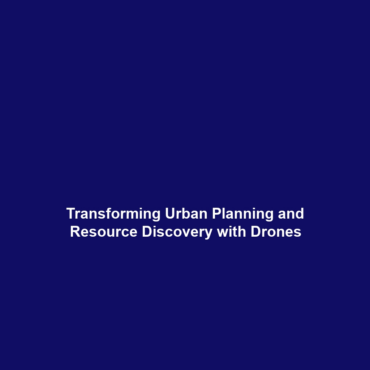Applications of Drones in Science: Urban Planning, Natural Resource Exploration, and Disaster Response
Introduction
Drones are rapidly redefining various sectors, particularly in urban planning, natural resource exploration, and disaster response. By leveraging the capabilities of drones in science, researchers and city planners are streamlining processes, enhancing data collection, and transforming emergency response strategies. As unmanned aerial vehicles (UAVs) continue to evolve, their significance in urban development, ecological monitoring, and crisis management becomes increasingly apparent. This article delves into the vital applications of drones in these critical fields, highlighting their role in advancing scientific research.
Key Concepts
The application of drones in science encompasses several principles and concepts that are essential to understanding their impact:
- Remote Sensing: Drones equipped with advanced sensors can capture high-resolution images and data from inaccessible areas.
- Geographic Information Systems (GIS): Integration of drone-collected data with GIS enhances urban planning and resource management.
- Data Analytics: Using algorithms to analyze data collected by drones enables effective decision-making in disaster response.
These concepts demonstrate how drones serve as a vital tool in the broader context of science, particularly in urban planning, natural resource exploration, and disaster response.
Applications and Real-World Uses
The applications of drones in urban planning, natural resource exploration, and disaster response offer innovative solutions to various challenges. Here are notable examples:
- Urban Planning: Drones are used to create 3D models of cityscapes for better infrastructure development.
- Natural Resource Exploration: UAVs assist in mapping mineral deposits and monitoring changes in land use.
- Disaster Response: Drones provide real-time aerial imagery of disaster-stricken areas, facilitating efficient rescue operations.
This highlights how drones are transforming the landscape of science and practical applications in these critical areas.
Current Challenges
Despite their benefits, the application of drones in these fields faces several challenges:
- Regulatory restrictions concerning airspace and privacy issues.
- Technical limitations including battery life and payload capacity.
- Data integrity and security concerns in remote sensing applications.
Addressing these challenges is essential for the continued advancement of drones in science.
Future Research and Innovations
The future of drones in urban planning, natural resource exploration, and disaster response is promising, with ongoing research focusing on:
- Next-gen drone technologies equipped with AI for better data processing.
- Improved battery systems for longer flight times.
- Enhanced sensors for more precise environmental monitoring.
These innovations are pivotal in advancing the scope and effectiveness of drones in various scientific applications.
Conclusion
In summary, the applications of drones in urban planning, natural resource exploration, and disaster response represent a significant advancement in the field of science. As technologies evolve, the accurate data and real-time analysis provided by drones will continue to improve decision-making processes and enhance responsiveness to critical situations. For further exploration of this topic and related areas, visit our pages on urban planning technologies and disaster management innovations.
